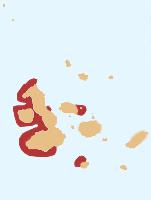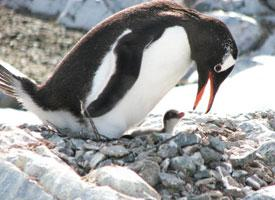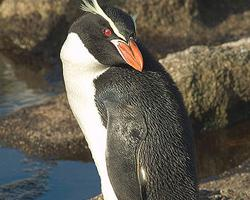
Súlyok és méretek
| Marmagasság | 48-tól 53-ig cm |
|---|---|
| Súly | 2,5-tól 2,7-ig kg |
Veszélyeztetettség
| Veszélyeztetett |
Állatleírás
The Galápagos penguin (Spheniscus mendiculus) is a unique and fascinating species of bird that is native exclusively to the Galápagos Islands, a volcanic archipelago located about 1,000 kilometers west of Ecuador in the Pacific Ocean. This species holds the distinction of being the only penguin species found north of the equator, thanks to the cool waters brought by the Humboldt and Cromwell currents, which make the Galápagos Islands a suitable habitat for these birds.The Galápagos penguin is one of the smallest members of the penguin family, with adults typically reaching a height of about 49 to 50 centimeters (19 to 20 inches) and weighing approximately 2.5 to 4.5 kilograms (5.5 to 10 pounds). They have a distinctive appearance, with a black head and two white lines that run from the eye to the chin, a black band across the chest, and a mainly black back, which contrasts sharply with their white belly. This countershading aids in camouflage, protecting them from predators both above and below in the water.
Adapted to their tropical environment, Galápagos penguins have several unique features. Unlike their Antarctic relatives, they have developed behaviors to cope with the warmer climate, such as panting and stretching their flippers to avoid overheating, and seeking shade during the hottest parts of the day. They are also known to take advantage of the cool waters surrounding the islands for feeding and regulating their body temperature.
Their diet primarily consists of small fish and crustaceans, which they hunt during the day. These penguins are excellent swimmers, utilizing their flippers for propulsion and their feet and tail for steering and braking. They can dive to depths of up to 60 meters (about 200 feet) in search of food, though they typically forage much closer to the surface and near the shore.
Breeding season for the Galápagos penguin is not fixed and can occur at any time of the year, depending on the availability of food resources. They are monogamous and often mate for life, nesting in caves or crevices to protect their eggs and chicks from the hot sun. The parents share the responsibilities of incubating the eggs and feeding the chicks, which helps ensure the survival of their offspring in the challenging environment of the Galápagos.
Unfortunately, the Galápagos penguin is classified as endangered due to a combination of factors, including climate change, predation by introduced species, and human disturbances. El Niño events, in particular, can drastically reduce their food supply, leading to significant declines in population numbers. Conservation efforts are underway to protect this unique species, including habitat restoration, predator control, and research to better understand their ecology and needs.
Despite the challenges they face, the Galápagos penguins continue to thrive in their unique habitat, enchanting visitors with their playful behavior and serving as a symbol of the delicate balance of ecosystems in the Galápagos Islands. Their presence highlights the importance of conservation efforts to preserve the unique biodiversity of this UNESCO World Heritage site for future generations.
Előfordulási térkép

Hasonló állatok
Új állatfotók
Top 10 állat
- Dolphin gull (Leucophaeus scoresbii)
- Diana monkey (Cercopithecus diana)
- Moustached guenon (Cercopithecus cephus)
- Galápagos tortoise (Geochelone nigra complex)
- Japanese macaque (Macaca fuscata)
- Russian tortoise (Testudo horsfieldii)
- Stone loach (Barbatula barbatula)
- Greek tortoise (Testudo graeca)
- Common flying dragon (Draco volans)
- Vendace (Coregonus albula)


